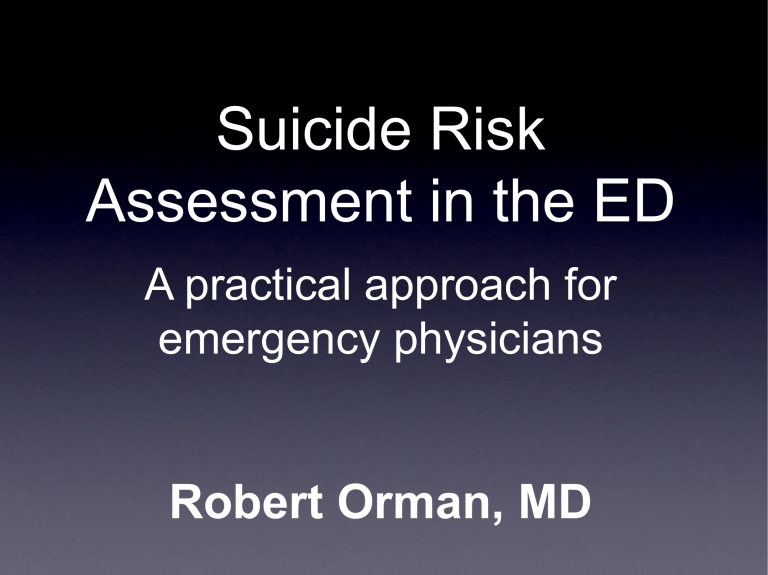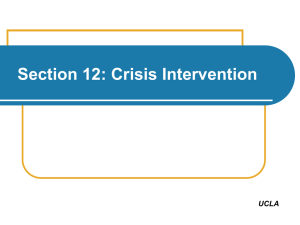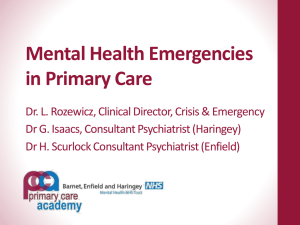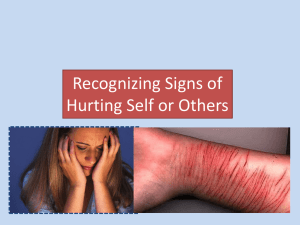Suicide Risk Assessment in the ED

Suicide Risk
Assessment in the ED
A practical approach for emergency physicians
Robert Orman, MD
Is this important?
References and show notes
• www.ercast.org
• references, mnemonic card, documentation template
• This is a new method
• get the flavor, use it, make it your own
• Thanks to Jeff Young MD
• Lecture references
References Here
Topics
• Why is this challenging?
• How can we do it better?
• Special circumstances
The challenge
Residency
• Case: Isolated suicidal ideation (SI)
• How often do you evaluate suicide risk?
• Med clearance, medical management
• What questions to ask in SI
The Challenges
• No gold standard test
• Qualitative and descriptive not binary decision
• yes/no versus maybe
• Less training than with medical emergencies
The Reality
• The ED is a busy place
• You are the rate limiting step
• Thorough, focused, organized = good
• Haphazard, different every time = bad
Estimate = Predict
• What questions to ask
• Estimate risk
• Estimate = Predict
• Communicate with patient, family, friends
• conclusion script, no certainty
Documentation
• Risk assessment paragraph
• most mental health patients you see
• Not long or complicated
• organized
• reflect your thought process
The Method: documentation
• Suicide risk assessment....
• 1. Risk factors/warning signs
• 2. Protective factors
• 3. Collateral information
• 4. Estimate of suicide risk
• 5. The plan
The Method: documentation
• 1. Risk factors/Warning signs
• increase chance of suicide
• "Mr. X presents with multiple risk factors including...”
The Method: documentation
• 2. Protective factors
• decrease chance of suicide
• "There are some protective elements, such as..."
The Method: documentation
• 3. Collateral information
• Who else did you talk with about the current situation?
52
The Method: documentation
• 4. Your estimate of suicide risk
• "My conservative estimate of this patient’s suicide risk is... (low, medium, high)
• Risk is a continuum, shades of gray
• Not a teeter totter or scale
The Method: documentation
• 4. Your estimate of suicide risk is based on:
• Risk and protective factors
• Extent of support
• Change of condition in ED (better or worse)
• YOUR CLINICAL JUDGEMENT
52
The Method: documentation
• 5. The Plan
• Discharged? What to do if increased SI
• Admit? Why
• How does plan mitigate immediate suicide risk?
• Partner with family, friends
• "Contracts for safety" = Magical thinking
The Method: documentation
• Suicide risk assessment....
• 1. Risk factors/warning signs
• 2. Protective factors
• 3. Collateral information
• 4. Estimate of suicide risk
• 5. The plan
How do we acquire and synthesize all of this information?
The Method: decision tools
• PERC, Ottawa Ankle rules, Wells score
• Guide workup, treatment, disposition
• Do decision tools work for SI?
7,11,26,30,35
The Method: decision tools
• Suicide risk scores
• not effective for quantitative risk measurement
7,11,26,30,35
The Method: decision tools
• What good are they?
• Bring together common risk factors
• Consistent/thorough line of questions
• Clinical judgment rules the day
• NOT a number or score
7,11,26,30,35,38
The Method: decision tools
• SAD PERSONS most studied in ED
• Quantitative risk score :-(
• No protective factors :-(
• Easy to remember what to ask :-)
7,24,29,37-39
The Method: next generation
• SAD PERSONS as question base
• Some parts taken out
• New ones added
• Information collected
• more complete picture of suicide risk
• TRAAPPED SILO SAFE
7,24,29,37-39
TRAAPPED SILO
SAFE
• High yield
• Baseline/chronic risk factors
• Warning signs/acute risk factors
• Protective factors
Chronic vs Acute risk factors
• Baseline/chronic can't be changed
• age, previous attempts, previous hospitalizations
• Warning signs/acute --> destabilize pt.
• May be amenable to intervention
• agitation, worsening depression, acute suicidal ideation
42
T
rigger
• Event or circumstance that led to this
• Subjective perception more important than quantity or type
• avoid judgment of triviality
• Anything that acts as acute stressor
• Acute/destabilizing risk factor
8,15,36
T
rigger
• Loss. Loss of a Job, relationship, financial support, loved one
• Disappointment or embarrassment
• Anniversary of significant interpersonal loss
• Recent (failed) psychiatric admission or suicide attempt
• In teenagers, recent suicide by a peer
R
ational Thinking Loss
• Red flag. High yield
• Acute tx can have a significant impact
• Psychosis, agitation, debilitating anxiety
• Eval and treat versus H&P
5
R
ational Thinking Loss
• More severe symptoms=increased risk
• Unlikely to discharge but still need to tx
• risk in hospital
• After tx, risk estimate may change
5
A
ge
• Not a protective factor
• Two groups to watch for. >65 and 15-24
• Elderly less warning, more lethal
• Elderly 4:1, young 200:1
• Suicide 3rd leading cause of death in 15-24
8,15,17,23
A
ccess to means
• Many paths to suicide, but...
• Limit availability of potentially lethal methods
• meds
• firearms
6,36
A
ccess to means
• Why are firearms important?
• 60% of suicide deaths in US
• #1 modality all age groups, gender
A
ccess to means
P
revious Attempts
• Reflex to doubt veracity of SI with previous attempts
• 38x suicide risk
• Higher in 1st year after
• Ask about most lethal previous attempt
• breaking the barrier
P revious Psychiatric
Care
• “Have you ever been hospitalized for mental health issues?”
• proxy for severity of underlying mental illness
• Recent hospitalization
• destabilizing
• increases risk
P revious Psychiatric
Care
• Does hospitalization protect from self harm?
• Why admit in the first place?
• manage acute issues
• not a panacea
• can increase risk
E
xcessive EtOH/Drugs
• 50% of suicides +EtOH
• Acute intoxication
• often part of attempt substrate
• impulsive
• many don't remember when sober
• Used in conjunction with attempt=increased future attempts and suicide
E
xcessive EtOH/Drugs
• What about SI when drunk, denies when sober?
• Still at risk
• Chem dependency needs to be part of dispo plan
• Cases
D
epression
D
epression
• Increase severity = increased risk
• Hopelessness = Red flag
• May indicate more severe depression
• end point of ‘no other way out’
• Less severe = less risk (but not zero)
Risk factors so far
• T rigger
• R ational thinking loss
• A ge
• A ccess to means
• P revious attempt
• P revious psych care
• E xcessive EtOH/Drugs
• D epression/Hopelessness
S
ickness
• Functional limitations
• Depression
• Chronic pain
• Increased dependence on others
• Epilepsy, CNS d/o, malignancy
• focus on effect rather than illness
I
deation
• Heavily weighted warning sign
• Intensity
• Persistent of fleeting?
• Unrelenting and obtrusive?
• Acute or chronic
• Formulation of plan?
I
deation
• Does denial of SI decrease risk?
• Only one of many risk factors
• Consider in context
• Many suicides happen with recent denial of SI
• 78% of inpatients who committed suicide either in the hospital of shortly after discharge denied suicidal ideation in their last psychiatric interview prior to suicide. J Clin Psy 2003
I
deation
• Discrepancy between perceived risk and denial of SI
• "You've told that you aren't thinking about suicide and that you don't want to die, but your behavior and what your family says suggests otherwise. It almost seems like you're telling me one thing but thinking another. Help me make sense out of this."
L
ack of social support
• Patient’s perception is key
• may not mesh with what you see
• Elderly -> family discord
• Collateral information
• nobody there? red flag
O rganized or serious attempt
• Should you ask about SI or plans?
• Can you plant the idea?
O rganized or serious attempt
• Intent to die
• Begin with details of attempt
• More detailed = greater risk
• Plan to avoid detection = greater risk
• 2 OD cases. Which is higher risk?
O rganized or serious attempt
• “What did you think would happen?”
• "What thoughts were you having beforehand that led up to this attempt?"
• "How do you feel now?"
• If no attempt, why not? Possible protective
Risk Factors
• S ickness
• I deation
• L ack of social support/isolation
• O rganized/serious attempt
• Are some more important than others?
High risk clusters?
• Some factors carry higher statistical risk
• depression, prev attempts, ideation
• Unique effect on each patient
P
rotective factors
• S upport
• A wareness
• F uture oriented
• E ngaged
S
upport
• Sense of connection
• Family, friends, network
• Religion (social, moral)
• Marriage
A
wareness
• Insight
• Coping skills
• Decision Making
F
uture oriented
• Looking forward to future events
• Reasons for living
E
ngaged
• Engaged in therapeutic process
• Not withholding
• Willingness to participate
What you have so far...
• TRAAPPED SILO SAFE
• Organize assessment
• Screen who needs
• admit/immediate psych workup
• discharge/urgent psych workup
Discharge plan
• Intervention matches suicide risk
• Involve family/friends
• especially with discharge
• Remove access to firearms, potentially lethal meds
Special circumstances
• Command hallucinations
• Self mutilation/cutting
Command hallucinations
• Do they increase suicide risk?
• Psychosis
• Up to 80% follow some commands
• "Have you ever done anything the voices told you to do?"
Self mutilation/cutting
• Is this a suicide attempt?
• Non-suicidal self injury
• Tension release, lysis of depersonalization
• Impulsiveness, poor coping skills
• Documentation
• avoid ‘gesture’. just describe
Wrap up
• How to use
TRAAPPED SILO SAFE
• Use mnemonic template
• get as much information as possible before entering room
• demographics, past history/attempts
Wrap up
• Suicide risk assessment tool
• high yield information
• NOT high yield groupings
• Facilitate clinical judgement
• in context of each patient
Wrap up
• Who should get a suicide risk assessment?
• mental health patients
• medical patients with complaint of SI









